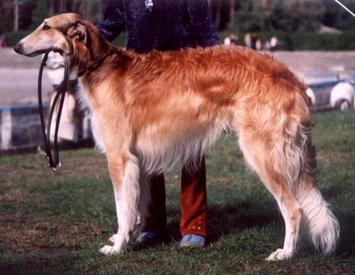
The Borzoi originates from...
Believed to descend from dogs brought to Russia from Central Asia in the 9th and 10th centuries and later by Mongol invaders coming from the East, the Borzoi has an ancient bloodline that has a colourful history. Many suggest at its lineage, the Borzoi can only officially be traced to 1650 Russia, where it was primarily bred for the purpose of coursing game and wolves across open land. Otherwise known as the Russian Wolfhound, the Borzoi's name derives from native Russian, meaning 'swift.' Widely used in hunting trials during the Tsar era, the breed gained popularity as the favoured dog of the royals and aristocracy, holding this reputation through the centuries. Sadly, following the Russian Revolution of 1917, many were slaughtered due to their affiliation with the aristocracy. This dog was officially recognised by the American Kennel Club in 1891.
The Borzoi is characterised by...
Often likened in appearance to the Greyhound, the Borzoi is thought to be the result of crossing between the Arabian Greyhounds and heavy-coated, native Russian dogs. A typical sight hound in its athleticism and stature, this breed is visibly streamlined for speed coursing, with straight, powerful legs, small ears, a long muzzle, and a deep, narrow chest. The coat varies in length, with longer hair found on the hindquarters, tail, and neck. Common colour variations include white, black, grey, or tan, usually with markings in black or gold.
The average Borzoi...
Despite the common misconception that it is a highly-strung and aloof breed the opposite is quite true. Neither aggressive nor temperamental, they display devotion and affection towards its master and family, being highly trainable and adapting well to new situations and people. Whilst exhibiting a certain shyness around strangers who it might initially perceive a threat, the Borzoi is gentle and mannered, well suited to the home setting, and active family life. On average, a healthy Borzoi will weigh 27-48kg depending on its gender, with a life expectancy of 10-12 years.
Weaknesses...
Sensitive to drugs, care needs to be observed at all times when administering treatment to the Borzoi. Typically healthy and resilient, the breed is susceptible to several genetic disorders including heart disease, optical disorders, and skin allergies. The Borzoi is known to suffer with bloat, a condition that can prove fatal, so a Borzoi should never be exercised directly after a meal.
Browse more breed facts and information, or shop our range of skin and coat products and dog digestion medication.








An excellent synopsis of the borzoi breed!
Borzois are spectacular athletes when running free, and beautiful, relaxing companions when lounging about indoors;- the perfect combination for me.
I'm sending a picture of "Krilov" sitting on my lap. Lots more pictures of me and my borzois on my website www.soozoo.demon.co.uk